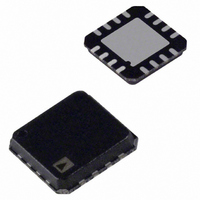AD8305ACP-R2 Analog Devices Inc, AD8305ACP-R2 Datasheet - Page 12

AD8305ACP-R2
Manufacturer Part Number
AD8305ACP-R2
Description
IC LOGARITHM CONV 100DB 16-LFCSP
Manufacturer
Analog Devices Inc
Type
Logarithmic Converterr
Datasheet
1.AD8305ACPZ-RL7.pdf
(24 pages)
Specifications of AD8305ACP-R2
Rohs Status
RoHS non-compliant
Design Resources
Interfacing ADL5315 to Translinear Logarithmic Amplifier (CN0056) Interfacing ADL5317 High Side Current Mirror to a Translinear Logarithmic Amplifier in an Avalanche Photodiode Power Detector
Applications
Fiber Optics
Mounting Type
Surface Mount
Package / Case
16-LFCSP
Other names
AD8305ACP-R2CT
AD8305
required to accommodate this situation (see the Using A
Negative Supply section).
The voltage, V
resistance of 4.55 kΩ, formed by the parallel combination of a
6.69 kΩ resistor to ground and the 14.2 kΩ resistor to the
VRDZ pin. When the VLOG pin is unloaded and the intercept
repositioning is disabled by grounding VRDZ, the output
current, I
where V
resistive loading on VLOG lowers this slope and also result in
an overall scaling uncertainty due to the variability of the on-
chip resistors. Consequently, this practice is not recommended.
V
V
and IREF may now be positioned at ground level by simply
grounding VSUM.
MANAGING INTERCEPT AND SLOPE
When using a single supply, VRDZ should be directly connected to
VREF to allow operation over the entire five-decade input current
range. As noted previously, this introduces an accurate offset
voltage of 0.8 V at the VLOG pin, equivalent to four decades,
resulting in a logarithmic transfer function that can be written as
where I
Thus, the effective intercept current I
thousandth of I
recommended value of I
The slope can be reduced by attaching a resistor to the VLOG
pin. This is strongly discouraged, in view of the fact that the on-
chip resistors do not ratio correctly to the added resistance. Also, it
is rare that one would want to lower the basic slope of 10 mV/dB; if
this is needed, it should be effected at the low impedance output
of the buffer, which is provided to avoid such miscalibration and
also allow higher slopes to be used.
The AD8305 buffer is essentially an uncommitted op amp with
rail-to-rail output swing, good load-driving capabilities, and a
unity-gain bandwidth of >12 MHz. In addition to allowing the
introduction of gain, using standard feedback networks and
thereby increasing the slope voltage V
to implement multipole low-pass filters, threshold detectors,
and a variety of other functions. Further details of these can be
found in the
LOG
N
) are used. When V
V
V
may also swing below ground when dual supplies (V
LOG
LOG
INTC
Y
LOG
= 44 μA × 4.55 kΩ × log
= V
= V
= I
= 200 mV/decade, or 10 mV/dB. Note that any
= V
= I
, generates a voltage at the VLOG pin of
LOG
AD8304
Y
Y
Y
REF
LOG
log
log
log
REF
× 4.55 kΩ
/104.
, is generated by applying I
10
10
10
, corresponding to 1 nA when using the
(I
(10
(I
PD
PD
data sheet.
N
/I
4
/I
= −0.5 V or larger, the input pins INPT
× I
REF
REF
INTC
)
PD
= 10 mA.
)
/I
REF
)
10
(I
PD
INTC
Y
/I
, the buffer can be used
REF
is only one ten-
)
LOG
to an internal
P
and
Rev. B | Page 12 of 24
(5)
(6)
RESPONSE TIME AND NOISE CONSIDERATIONS
The response time and output noise of the AD8305 are
fundamentally a function of the signal current, I
currents, the bandwidth is proportional to I
Figure 15. The output low frequency voltage-noise spectral-
density is a function of I
small values of I
performance of translinear log amps can be found in the
AD8304 data sheet.
POWER SUPPLY SEQUENCING
Some applications may result in the presence of large input
signal current (>1 mA) prior to the AD8305 being powered on.
In such cases, it is recommended that power supply sequencing
be implemented such that the AD8305 is powered on prior to
the photodiode or current source.
In those applications where it is not possible to implement
supply sequencing, VSUM should be driven externally by a low
impedance source. In applications where a low-impedance bias-
source is not readily available, the circuit shown in Figure 34
can be used.
The 2N2907 transistor used in Figure 34 is a common PNP-type
switching transistor. R
at the base of the transistor is ~0.5 V.
In general, V
Setting R
quiescent current for a 3 V supply under normal operation.
Larger resistor values may be used for this divider network by
choosing a transistor with a higher β than the 2N2907.
Given a typical V
the AD8305 is off and a large input signal is being applied. Once
the AD8305 is powered on the voltage at VSUM is pulled down
to its nominal value of 0.5 V. The circuit in Figure 34 is tested
for 3 V to 5 V positive supplies over the full temperature range
for the AD8305. C
Figure 34. VSUM Biasing Circuit for Applications Where Large Input Signals
≈0.5V
a
R
R
= 5 kΩ and R
A
B
+V
S
S
× [R
V
–
REF
Are Present Prior to AD8305 Power-On
BE
β
be
+
1
. Details of the noise and bandwidth
b
, and R
of 0.7 V, the voltage at VSUM is ~1.2 V when
/(R
2N2907
I
I
E
C
a
a
+R
and R
+V
b
PD
= 1 kΩ, results in 500 μA of additional
BIAS
1
b
(Figure 17) and also increases for
)] should equal approximately 0.5 V.
R1
are the components that make up
C1
b
C
are selected such that the voltage
I
PD
2
INPT
VSUM
VPOS
VNEG
+V
PD
P
, as shown in
COMM
PD
. For small













